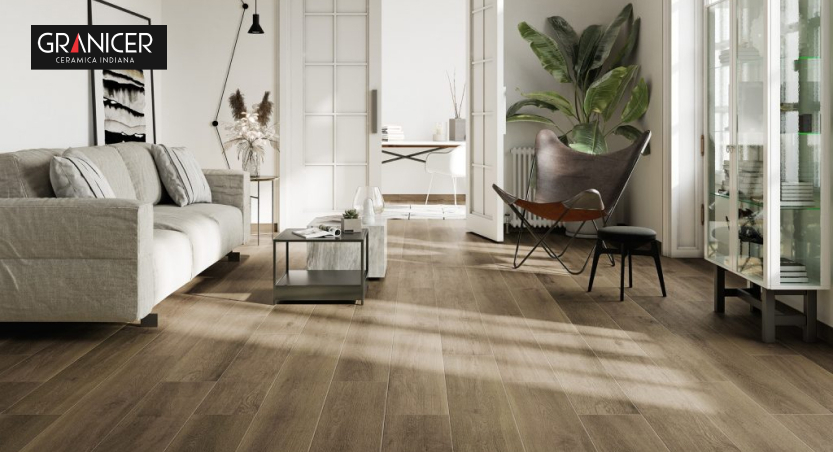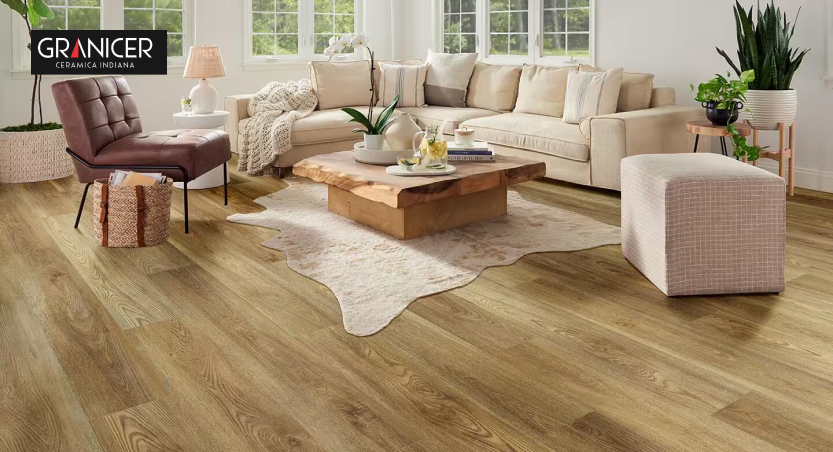
Wooden floors have always been popular for their classic beauty and durability. However, they might not be the best option if you're concerned about budget and maintenance. While hardwood floors can last a long time and even look better with age, they have drawbacks.
That's where wood-look porcelain tiles come in. These tiles mimic the look of natural wood but have many added benefits. They are becoming a popular alternative to hardwood and engineered wood flooring. If you're wondering why so many homeowners are making the switch, you're in the right place.
In this blog, we will explore the top reasons why wood-look porcelain tiles might be the perfect choice for your home and the factors to consider before selecting them.
What Is a Wood-look Tile?
Wood-look tile is a manufactured tile made from either porcelain or ceramic. These tiles are specially designed to replicate the appearance of natural wood, offering the visual appeal of wood with the added benefits of tile. Unlike natural wood, which is more porous and susceptible to wear and tear, wood-look tiles are known for their durability.
The manufacturing process allows these tiles to emulate various wood grains and finishes, making them versatile for different interior design styles. If you're considering a durable and stylish flooring option, exploring what a reputable porcelain tile company like Grancier (yeah, that's us) has to offer might be the perfect start.
Wood Look Tile vs. Hardwood: What is Better
Choosing between wood-look tile and hardwood can be challenging, as one offers the authenticity of natural wood, and the other provides a similar aesthetic with additional benefits. Which one should you choose? The answer depends on your needs and preferences.
In this section, we'll compare the two options based on six key reasons to help you make an informed decision.
Minimal Maintenance

In today's busy world, the last thing you need is high-maintenance flooring. Durability and ease of maintenance are crucial factors, especially in homes with kids, pets, and heavy foot traffic. Plain Wood Porcelain tiles stand out in this regard, offering significant advantages over hardwood floors.
Porcelain tiles are gaining popularity because they are incredibly easy to maintain, particularly in high-moisture areas like bathrooms and kitchens. Unlike hardwood, which is susceptible to water damage, spills, and scratches from pets' nails, porcelain wood look tiles are water-resistant and scratch-resistant. This makes them a worry-free option for active households.
Hardwood floors require more effort to keep them in good condition. They need protection from spills and water damage, and regular sanding and refinishing to maintain their appearance and extend their lifespan. In contrast, a wood look porcelain tile is low-maintenance and easy to clean, providing a hassle-free flooring solution that maintains its beauty over time.
Longevity
Longevity is a crucial factor when choosing flooring for your home. Wood-look porcelain tile excels in this aspect compared to hardwood flooring.
Porcelain tiles are engineered to last for decades with minimal wear and tear. They are highly resistant to scratches, dents, cracks, and moisture, ensuring their appearance remains consistent. Porcelain is also impervious to temperature fluctuations and humidity, making it an ideal choice for areas with varying climatic conditions.
In contrast, hardwood floors, being a natural material, are more prone to wear and tear due to environmental factors. They can suffer from scratches, dents, and discoloration over time. Hardwood is also vulnerable to moisture and temperature changes, which can cause warping, swelling, or shrinking. These issues necessitate regular maintenance and may require replacing planks to maintain the floor's appearance and integrity.
Versatile Designs
While hardwood floors come in shades of brown and offer a natural, timeless look, their design options are somewhat limited. Hardwood typically comes in standard plank sizes and lacks the variety of shapes and patterns available in porcelain tiles.
On the other hand, a porcelain tile that looks like wood offers an incredible range of design possibilities. They come in numerous sizes and patterns, allowing you to create unique and personalized flooring designs. Whether you prefer the look of traditional wood grains or want to experiment with more creative patterns and colors, porcelain tiles give you the freedom to express your style.
For instance, mix and match different wood look tiles, such as glamour wood choco with seol teak brown, to create a striking pattern that stands out. Additionally, porcelain tiles are available in distinctive colors and finishes that you won't find in hardwood. This means you can achieve various looks, from contemporary to rustic, ensuring that your flooring complements your overall aesthetic.
Suitable for All Areas
Porcelain wood-look tiles are perfect for a wide range of applications in your home, both indoors and outdoors. Their non-porous and moisture-resistant properties make them ideal for high-moisture areas such as bathrooms, kitchens, and outdoor spaces.
These tiles come in various textures, allowing for customization to fit any design theme, whether traditional or modern. Beyond being water and stain-resistant, these tiles are also fireproof, enhancing their safety and durability. This makes them a perfect choice for both residential and commercial spaces.
Porcelain tiles are available in multiple sizes, ensuring they can easily fit into any room. They are particularly advantageous in homes in humid and warm regions, as their cool surface provides a comfortable underfoot experience. Additionally, their smooth texture reduces the amount of dirt and dust that clings to the floor, contributing to a cleaner indoor environment.
In contrast, natural hardwood flooring is less moisture-resistant, making it unsuitable for bathrooms and other wet areas. However, due to its natural warmth, hardwood can still be a good option for living spaces in warmer climates.
Superior Moisture Resistance
Wood-look tiles are water and moisture-resistant, allowing for easy daily cleaning without the risk of water absorption or damage. This feature ensures that the tiles retain their appearance and structural integrity over time.
On the other hand, hardwood floors are less resistant to moisture. Exposure to water can cause hardwood to discolor, warp, and even develop mold and mildew. This not only compromises the look of the floor but also poses health risks, as mold spores can be harmful. Additionally, damaged hardwood can produce splinters, which can be a safety concern, especially for homes with kids and elderly residents.
More Value for the Money
Advances in technology have made it possible to produce porcelain tiles that closely mimic the appearance of exotic hardwoods. These tiles come in various sizes and maintain their durability over time, often lasting for decades and making them a sound long-term investment.
In contrast, installing real hardwood flooring involves a significant upfront cost and requires ongoing maintenance, such as sanding and refinishing, which can be expensive. While hardwood has a timeless appeal, the costs of maintaining its appearance can add up over the years.
How to Select Wood-Look Tile For Your Home
When selecting a wood-look tile, the three primary factors to consider are color, size, and rating. Each of these elements can significantly impact your space's overall look and feel.
1. Color:
Color is crucial in setting a room's tone. Light colors make a space feel larger and more open, while darker shades add warmth and coziness. When choosing a color, consider how it will interact with the existing décor and how it will wear over time. Lighter tiles can help camouflage scratches and wear, while darker tiles may show less dirt and stains. For a space like a bathroom or kitchen, patterned or brightly colored porcelain tiles can add character and vibrancy.
2. Size:
The size of the tile can dramatically alter the perception of a room's dimensions. Our large-format porcelain tiles come in 60x120 cm, which can make small spaces appear more expansive, creating a seamless look with fewer grout lines. Conversely, smaller tiles can make an area feel more intimate and detailed. Consider the room's proportions and the visual effect you want when choosing tile size.
3. Rating:
Tiles are graded and rated for durability and suitability for different environments. The Porcelain Enamel Institute (PEI) rating indicates the tile's hardness and resistance to wear. A PEI rating of 3 or higher is usually sufficient for residential spaces with moderate traffic. For high-traffic commercial areas, look for tiles with a PEI rating of 4 or 5. Additionally, tiles from trusted porcelain tile companies will meet high quality and durability standards, ensuring your investment lasts for years.

Beautify Your Home With Wood Look Porcelain Tiles

Wood-look porcelain tiles clearly have the upper hand compared to hardwood, meeting all your criteria for durability, cost-effectiveness, appearance, moisture resistance, and versatility. For these reasons, we highly recommend them for your home renovation projects.
When looking for a top-quality porcelain tile company with a global presence, advanced technology, and skilled human resources, Grancier stands out. Founded in 2007 in India, Grancier has been delivering high-quality porcelain tiles, including vitrified, GVT, PGVT, wall, and large-format porcelain tiles. Our state-of-the-art facilities and innovation commitment ensure you receive the best products available.
For more information about us, visit Grancier and discover how our tile options can transform your home.
If you want to learn more about porcelain slab tiles, read our blog here.